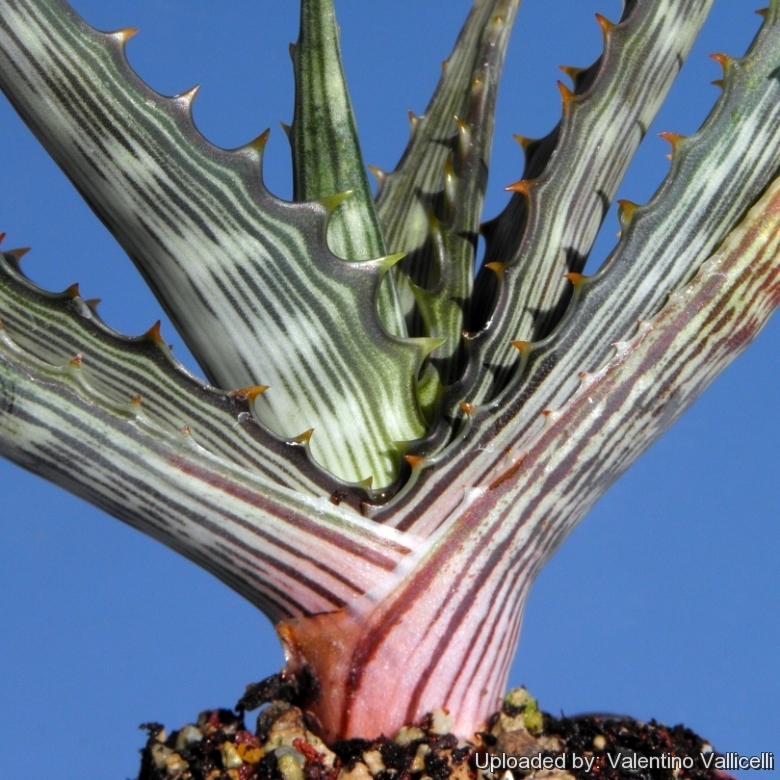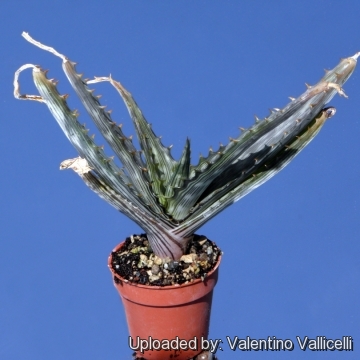




Your support is critical to our success.

Origin and Habitat: South Africa. North-eastern Transvaal (Drakensberg Mountains in the Ohrigstad, Lydenburg and Roossenekal Districts)
Habitat: It grows in subtropical bushveld, between bushes and shrubs, sometimes in more open areas.
Synonyms:
- Aloe fosteri Pillans
ENGLISH: Large Spotted Aloe, Foster's Spotted Aloe
Description: Aloe fosteri is one of the stemless spotted leaf aloes somewhat similar in general appearance to many other spotted species of aloe in the section Saponariae, but this is surely one of the best looking of them all. It also produces highly branched inflorescences, with some of the best looking flowers of the spotted aloes.
Habit: It forms basal rosettes 60-90 cm across, and usually slow to sucker, if at all (unusual for a spotted aloe).
Leaves: Long, attractive, thin, borne almost in two rows, about 20-40 cm long, 8-10 cm wide, dull green to pale blue-green with numerous cream spots in transverse bands and H-shaped markings on the upper surfaces and lined on the reverse throughout their entire length. Margin with prominent, very sharp, teeth 3-4 mm long, 10-15 mm apart, reddish-brownish. As with most of the spotted aloe the leaf tips dry, turn brown and curl. Leaf sap purple.
Inflorescence: Produces one flower spike at a time, dark purplish colour covered with a grey powdery bloom, with about 8 branches (dozens sometimes) up to 90-120(-200) cm tall. Racemes cylindrical.
Flowers: Flower colour can be red, scarlet, orange, red-orange, bright yellow
Blooming season: Autumn
Bibliography: Major references and further lectures
1) Urs Eggli “Illustrated Handbook of Suculent Plants: Monocotyledons” Springer, 2001.
2) Walther Haage “Cacti and succulents: a practical handbook” Dutton, 1963
3) John Manning “Field guide to wild flowers of South Africa, Lesotho and Swaziland” Struik, 15/Apr/2010
4) Susan Carter, John J. Lavranos, Leonard E. Newton, Colin C. Walker “Aloes. The definitive guide” Kew Publishing, Royal Botanic Gardens, Kew 2011, ISBN 978-1-84246-439-7, S. 251.
5) Court, D, 1981. “Succulent flora of Southern Africa” Balkema, Cape Town.
6) Leistner, O.A. 2005. “Seed plants of southern tropical Africa” SABONET, Pretoria.
7) Nichols, G. 2005. “Growing rare plants, a practical handbook on propagating the treatened plants of southern Africa” Southern African Botanical Diversity Network Report No. 36. SABONET, Pretoria .
8) Reynolds, G.W. 1950. “The aloes of South Africa” The Aloes of South Africa Book Fund, Johannesburg.
9) Van Jaarsveld, E., Van Wyk, B-E. & Smith, G. 2000. “Succulents of South Africa” Cape Town , Tafelberg
10) Van Wyk, A.E. & Smith, G. 2001. “Regions of floristic endemism.” Umdaus Press, Hatfield.
11) Van Wyk, B. & Malan, S. 1988. “Field guide to the wild flowers of the Highveld.” Struik, Cape Town.
12) Williamson, G. 2000. “Richtersveld. The enchanted wilderness” Umdaus Press,
13) Hans Bornman, David S. Hardy “Aloes of the South African veld” Voortrekkerpers, 1971
14) Pooley, E. 1998. "A field guide to the wild flowers of Kwazulu-Natal and the Eastern Region." Natal Flora Publications Trust, Durban.
15) Barbara Jeppe “South African aloes” Purnell, Cape Town. 1974
16) Ben-Erik Van Wyk, Gideon Smith “Guide to the Aloes of South Africa” Briza Publ., 1996 ISBN 1-875093-04-4
17) Van Wyk, B-E. & Smith, G. 1996. “Guide to the aloes of South Africa” Briza Publications, Pretoria.
18) Braam Van Wyk, Sasa Malan, Timothy Kemper Lowrey, Anne Pienaar “Field Guide to the Wild Flowers of the Witwatersrand & Pretoria Region: Including the Magaliesberg & Suikerbosrand” Struik, 1988
19) Braam Van Wyk “A Photographic Guide to Wild Flowers of South Africa” Struik, 2000

Aloe fosteri Photo by: Valentino Vallicelli
The gallery now contains thousands of pictures, however it is possible to do even more. We are, of course, seeking photos of species not yet shown in the gallery but not only that, we are also looking for better pictures than those already present. Read More...
Cultivation and Propagation: It is relatively easy to cultivate under a wide variety of climatic conditions provided it is planted in a well-drained situation given adequate water but not over-watered.
Soil: Grow it in an open sandy-gritty well-drained cactus compost.
Pots: It needs a relatively shallow pot to accommodate its fibrous roots and provide a very good drainage. It may stay in the same pot for many years.
Watering: Water in moderation. Keep dry in winter or when night temperatures remain below 10° C. Water it less than average if in bigger pots.
Special need: Provide very good ventilation. Nearly all problems occur as a result of overwatering and poor ventilation, especially when weather conditions are dull and cool or very humid.
Fertilization: Light fertilizer seems to boost its growth whenever additional water is given.
Feed them during the growing season with a fertilizer specifically formulated for cactus and succulents (high potash fertilizer with a dilute low nitrogen), including all micro nutrients and trace elements diluted to ½ the strength recommended on the label. They thrive in poor soils and need a limited supplies of fertilizer to avoid the plants developing excess vegetation, which is easily attacked by fungal diseases.
Exposure: It enjoys light-shade. It may be grown in full sun too but protect in summer from afternoon sun, and avoid reflected heat. It will do its best with some sun and become stressed with inadequate light which could result in poor growth and unnatural shape. Direct sunlight along with prolonged drought and make the leaves turn a reddish colour, a sign generally associated with stress.
Hardiness: It likes warmth (recommended minimum winter temperature 5° C) however plants kept perfectly dry can can survive low temperatures, approx. -2° for short periods, but for safe cultivation it is best to avoid freezing temperatures.
Pest and diseases: Occasionally these plants are infested by scale and aphids, but all known garden pests can be kept to a minimum by simply ensuring optimal growing conditions and healthy plants.
Use: This is suited for a non heated green house. It can be also cultivated outdoors in raised beds, terraces if sheltered from winter rain. This aloe continues to be, a particular prize among collectors
Maintenance: Removal of old flower stalks; It is a suckering species, and one plant can eventually cover a large area. Divide the crowded clumps periodically. During the winter months, the plants should be grown cool to initiate flower development (about 5-10°C )
Propagation: Suckers, division of older plants. Seeds must be sown as fresh as possible. The best time for sowing would be in the late summer before winter sets in when temperatures are still warm. Use coarse, well-drained sandy soil and cover seeds lightly, then keep moist. Cover the seeds with a fine layer of grit and water from below with a with a long-lasting fungicide, as seedlings are prone to damping off, a fungus that eventually kills the young plants. For the 1-2 weeks cover the pots with a sheet of glass/clear perspex to keep the humidity levels high. Remove the glass and replace it with light shade-cloth and mist once or twice a day for the next two weeks after which most seeds should have germinated. From then on mistings can be reduced to every second and then every third day as the little plants grow. After germination, when plants are about 20–30 mm high, re-plant seedlings using a sandy loam medium and feed with organic fertilizer at least once a quarter to ensure healthy growth. By cuttings: remove offspring from the parent plant. Place the cuttings in the same mixture one uses for seeds. Use root hormone to stimulate root growth.
| Your Actions | |
|---|---|
| Back to Aloe index | |
| Back to Aloaceae index | |
 |
Back to Succulents Encyclopedia index |
Privacy stantement - Terms and conditions - How to cite - About us - Feedback - Donate



